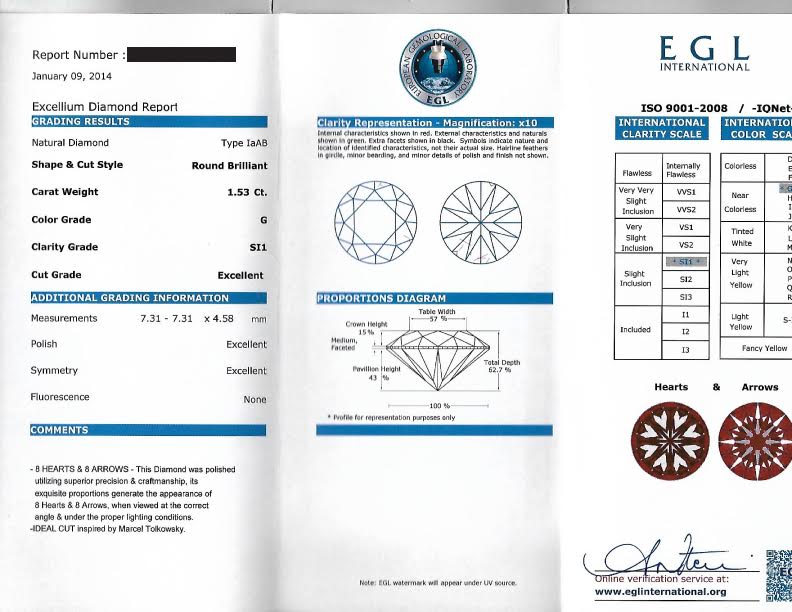When buying, and especially selling your diamond, it is important to know the true quality of your diamond. You, as a consumer, need to know the actual grades of your diamond in order to get the best pricing when buying and selling.
The Gemological Institute of America (GIA) is the world’s undisputed authority on diamonds and provides dealers and the public with lab reports. Being non-profit, the GIA supplies consumers (dealers and the public alike) with non-biased, conservative and consistent grading. There are other laboratories that are for-profit and more liberal in their grading, leading the consumer to believe they have a more rare, and in turn, more valuable diamond, when in reality the client paid a higher retail price than warranted.

I recently purchased a diamond from an individual, who had their original documentation, which is highly recommended. They were sold a 1.53CT round brilliant cut diamond with an EGL (European Gemological Laboratory) lab report; the EGL is a for-profit lab. The report stated the grades of the diamond were “G” color and “SI1” clarity, with an “excellent” cut grade. These grades are well above average, desirable and in combination would have the diamond generally retailing for around $14,600.
Upon close inspection, I noticed the diamond exhibited a slight yellow body color/warmth and there were a few small inclusions visible under 10x magnification. Based on my 9 years of experience and GIA diamond grading training, I concluded the diamond was a “K” in color and “SI2” in clarity. These grades in combination retail for somewhere around $7,000, depending on the store.

I explained this to the client, who was disappointed that the quality was actually lower than what had been represented when it was sold. We discussed at length and came to an agreement on a fair selling price.
In order to resell this diamond back to the wholesale market, I needed a GIA lab report. A week later, I was not surprised with the results the GIA provided. The diamond was indeed a “K” color and “SI2” clarity with a “very good” cut grade. The diamond was sold to the client as 4 color grades higher and one clarity and one cut grade above its’ true grades. The client had paid over DOUBLE what they should have if the diamond had originally been evaluated by the GIA.

The power is in the hands of the seller when they’re holding a GIA lab report on a diamond. This ensures the seller and the buyer are on the same page in regards to diamond quality. Capetown Capital Lenders shows clients comparable GIA graded diamonds on the wholesale market, in order to determine the diamonds’ true liquidation value. If you are considering selling or purchasing a diamond, we recommend relying on the GIA to ensure you are as informed as possible.
If you have a diamond you are interested in selling or using as collateral for an asset-based loan give me a call at 816-977-2677.
